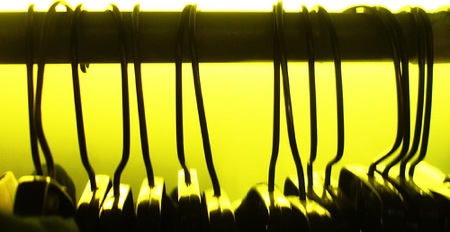A restaurant’s coatroom is a mysterious place. To guests, the coatroom is a maximum-security fortress where their coats, hats, umbrellas and luggage are ushered away before the meal and safeguarded under lock and key from prying eyes and thieving hands. They’re given a tiny ticket in exchange for these personal items, and under no circumstances is the guest ever allowed to peer into the coatroom—not even to identify a missing coat or umbrella.

There’s a clear reason for this surreptitiousness: it helps prevent the staff from unwittingly aiding in theft. On a Saturday night, there are hundreds of black three-quarter-length coats. When it rains, there are no fewer than two hundred different umbrellas in the average coatroom, the majority of which do not have a loop so that they can be easily hung. To allow a guest back into the coat room to identify his black trench coat is to permit a guest to enter the restaurant with an Old Navy coat and exit with an Armani one. The guest who has lost his ticket and is permitted to look around in the coatroom will naturally identify his coat as a $25,000 mink coat that may actually belong to a female at the bar. Or, after a cursory glance, he may suddenly recognize a vintage fedora on the shelf as one he ‘left at the restaurant weeks ago.’ There are other, less obvious reasons you’re not allowed into the coatroom as a guest, however.
It’s Not as Large as You Think It Is
A coatroom is a restaurant designer’s afterthought. Their rationale for making small coatrooms is understandable; after all, there’s only a few cold months in every year, and honestly, how many people are going to bring their luggage with them into a restaurant? Anyone who’s ever worked in the heart of a metropolis when a convention is in town can immediately recognize the folly in this reasoning.
It’s Not Just a Coatroom
A coatroom wears many hats—literally and figuratively. As the most convenient storage space on the restaurant floor, a coatroom is also the unofficial junk room, full of extra stools, high chairs, spare menus, candles, old special events décor, and the lost and found box. As unkempt as some coatrooms are, it’s a wonder that hundreds of coats, scarves and umbrellas can remain organized. And even then…
It’s Not Always Organized
In many restaurants, the responsibility of the coatroom falls upon the host staff. They are charged with the task of organizing the tags and handing out coat check tickets. This doesn’t automatically mean that the coat check tags are kept in order or stay in order throughout the evening. And as guests and staff misplace coat check tickets, the number of coat check tickets can dwindle to a precious few quickly, causing staff to resort to scribbled sticky notes, rubber bands and even colored paper clips as the volume of coats continues to grow.
It’s Also a Locker Room…
If the coatroom is situated close to the bar, host stand or lounge, there’s no way the staff that works in these areas is going to walk downstairs through the back of the house to get changed or to lock their clothes away if they’re not forced to. That means the coatroom becomes a repository of all of the things the bar, lounge and host staff bring to work—leftovers from staff meal, street clothes, shoes, backpacks, purses, wallets and hats. It also means that before and after their shifts, they’ll change into and out of their uniform. A stroll into the coatroom on any given volume night is entry into a Pandora’s box of semi-valuable clutter, half-eaten food and a staff member or two in various stages of undress.
…And a Cafeteria
Whether a restaurant provides staff meal for their staff or not, chances are good that on a busy Saturday night, someone’s going to get hungry. For hungry hosts that must stay near the host stand, a coatroom becomes the server’s equivalent of the coffee station, a place to grab a quick snack or chug a coffee. And it’s a surprisingly convenient place to hide pizza, sandwiches or chicken fingers to nibble on during the shift.